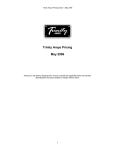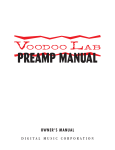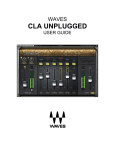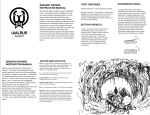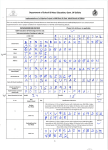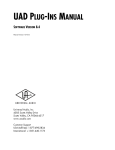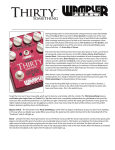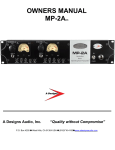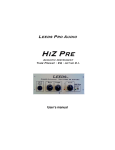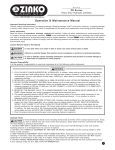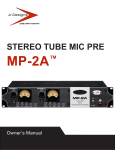Download Tech Specs - PRS Guitars
Transcript
Tech Specs 2 Channnel “C” and “H” amps Max Power Usage Pre Amp Tubes Service Notes Tubes 50 Watt 200W 3 each 12AX7/ECC83 3 each 12AT7 “C” Power Tubes 2EA EL34 “H” Power Tubes* 2EA 6L6 * Power Tubes should be purchased as matched sets. Use only tubes in quads that are factory-matched. Failure to use matched tubes can lead to tube failure and amplifier damage or abnormal operation. Main Fuses 120V 60Hz 3A 250V Type 20mm X 5mm 100V 50/60Hz 3A 250V Type 20mm X 5mm 230V 60Hz 1.5A 250V Type 20mm X 5mm Filament Fuses B+ Fuses 2 each 10A 250V Type 3AG/AB 1 each 1 Amp 250V Type 3AG/AB Weight Head 32.8 lbs (14.9kg) 1x12 Combo 62.8 lbs (28.5 kg) Dimensions Head 21.5” W x 10” H x 9.5” D 546mm W x 254mm H x 241mm D 1x12 Combo 24” W x 23” H x 11” D 609mm W x 584mm H x 279mm D Tubes are consumables, as they have a given usable lifespan. They are part of the heart of the tone, so keeping correctly operating tubes is essential. Tubes can fail catastrophically or gradually, and it’s good to know what to look for if they start to go bad. Periodically inspect them and look to see if anything inside the tube is glowing cherry red other than the normal orange glow of the filament. This would indicate a situation where the tube is conducting more current than it is capable of handling and most likely about to fail. Two other conditions to observe are: 1) filaments not glowing or 2) a miniature fireworks display inside the tube. Any of the above conditions indicate serious problems with the tube and should be taken care of immediately. Tubes quite often are the cause of spurious noise in the amp. Microphonic tubes will squeal or rattle with the vibrations of the cabinet. If suspected, tap each tube lightly with a pencil with the amp powered up—the suspect tube will let you know. Note that there is a normal metallic clinking when doing this, but a microphonic tube will be quite loud. Instructions for Qualified Service Technician: To install the tubes, check that the power cord is not plugged in, then remove the back panel with a screwdriver and notice the tube sockets. Note that the cooling fan may need to be unplugged from the chassis. Looking from the back, install the Power tubes (EL34, 6L6, etc.) in the sockets. In each case, align the center pin guide correctly with the socket, making sure that the pin guide key fits with the corresponding slot in the socket. The preamp tubes can then be placed in the smaller 9-pin sockets to the right of the power tubes. Please refer to the tube chart in this manual (inside, panel 4) for proper tube locations. Be aware of the pin alignment with these, as there is only one way they can fit. We utilize tube sockets that allow relative ease of tube installation, but never force tubes into the sockets if there becomes a problem. Also, never torque the tubes, only gently rock them from side to side during insertion or removal. After preamp tube installation, place the cylindrical spring tension preamp tube covers over the tubes. Replacing preamp tubes will not require any adjustment, but the power tubes will need rebiasing to assure proper operation. After power tube replacement, initially inspect the tubes often to assure there are no “cherry red” components within the tube. Tubes today can have a wide variety of tolerances and a re-bias is highly recommended with new ones. Fuses There are 4 fuses installed in the amplifier. 2 of these fuses are accessible on the back panel: the main fuse, and the B+ fuse. These are replaceable by the user. Two of these fuses are high voltage, and 2 internal fuses are for the lower filament voltages. In all cases, labels indicate the type and rating of the fuse. Replacement fuses MUST BE THE SAME TYPE AND RATING. If they are not you can permanently damage your amplifier. Please contact your local PRS dealer or the PRS accessories web site for information on ordering replacement fuses. Instructions for Qualified Service Technician: Replacement of internal fuses requires removal of the back panel and removal of the chassis. First, ensure the power cord is not plugged in, then remove the back panel with a screwdriver. Loosen the 4 screws holding the chassis to the top of the cabinet. Check that all components are cool so that burns do not occur. Then, by holding onto the transformers, carefully pull the chassis out of the cabinet. NOTE! Capacitors may retain an electric charge and can be dangerous even when the unit is off, unplugged, and has not been played for an extended period of time. USE CAUTION!!!! Locate the fuse holders, remove them, and check for continuity. Blown fuses can indicate a failure condition and should be treated as though a problem exists. Check the label for the proper type and rating. After all fuses have been replaced and the amp is tested as acceptable and safe, reinstall the chassis by working in reverse. Be sure to plug the reverb cords back into place. 2 Channel Guitar Amplifier User’s Manual Using your PRS Amplifier Back in 2006, I was at the Dallas Vintage Guitar Show and my band was scheduled to perform a few times. A friend said, “Hey. You need an amp to play through, and I have a friend who makes great amps.” He took me to the booth of a Texas amp builder, Doug Sewell. I loved the way his amps sounded, and after barely saying hello, Doug and I were inside rewiring the amp I was going to play through. Since that day, Doug and I have spent years rewiring and listening to every single possible variation to finalize the circuits. Our goal was to have highly usable and musical amplifiers. I am not an amp collector. I am an amplifier user who keeps the amps I am presently playing through. That said, after Doug and I got several of the prototypes finalized, I sold some of my old coveted live and studio amps because ours sounded considerably better. The next step was to take the prototypes to musicians who are known for their amplifier tone as well as their playing. What’s interesting is that when I spoke to these artists about trying the amps, they all said the same thing. “Sure I’ll use them, if I love them.” In a real way, amplifiers are musical instruments. They are the devices that “amplify” the sound of the player’s hands, the guitar and possibly the pedal board. They must share many qualities. They must work - they have to have a beautiful balance of bass, midrange, and treble; the highs should be sweet - not harsh; they should be easy to operate and be highly musical. In addition, amps should clean up really well when you turn your guitar down. The final quality that Doug and I looked for are amps that sound good no matter where the knobs are. It is a rare quality that we insisted on. I hope this hand-crafted amplifier gives you years of enjoyment, musical results, and pride in ownership. I appreciate your confidence. IMPORTANT: Before using your amplifier, refer to the IMPORTANT SAFETY INSTRUCTIONS insert supplied with the product. Powering Up: 1. Make sure your speaker cabinet is connected to the correct speaker output impedance jack with a high quality speaker cable. Do not use guitar cords. 2. Make sure the power cord is connected to the correct grounded outlet. 3. Make sure there is at least 6 inches of clearance behind the amplifier to allow for proper cooling. Never place the amplifier against a wall or other equipment, and keep it clear of other heat sources, such as other amplifiers or stoves. Make sure there are no flammable items, such as curtains, behind the amp. Do not drape items over the amps that can prevent proper cooling. Do not set drinks or other liquids on top of the amp that can spill into the amp. 4. To increase the life of the tubes, set the “On/Standby/Off” switch to the STANDBY position before powering on. Let the amp warm up for 2 minutes before setting the switch to ON. If this is the first time you are turning on the amp, check to see if all of the tubes are glowing. 5. Plug in the guitar cable, turn the volume knob down and turn the standby switch on and wait a few seconds for the bias to settle. Bring the volume up and play some tunes. Clean Master: Gives you incredible control to find the perfect balance of volume compared to your Lead channel On/Standby/Off: When this switch is in STANDBY, the amplifier tubes are effectively turned off, but are still being warmed by the filaments. Keep this switch set to STANDBY when powering on the amplifier for at least 2 minutes to allow the tubes to warm up. This also helps extend the life of the tubes. When set to ON, the tubes are turned on, and the amplifier can be used. Jewel Power Indicator: If the jewel is lighted, the amp is on. NOTE: An amplifier may be plugged in and “on”, but a malfunctioning or burnt-out indicator will not show the amp is on. Check the power cord and Power Switch if the jewel light is not on. If these are connected correctly, then check the main fuse. If the main fuse burns out, check for proper speaker connections. If the fuses continue to blow, the amplifier may need servicing 2 Channel Amplifier Back Panel Controls Footswitch Jack: Connect the included footswitch to control channel switching and global reverb. This bypasses your Lead/Clean Selector on the front of your amp. The 2 Channel “C” lets old-school tonehounds mix the classic vintage tones of the 50’s and 60’s. Its custom-made Cinemag transformer and EL34 power tubes combine the warm, soft cleans of a classic tweed and the syrupy, crunchy overdrive of the late 60’s Brit amps. The 2 Channel “H” steers toward the tight, punchy sounds of the 80’s and 90’s, while leaving room to invent a new sound for the future! It uses a Heyboer transformer and 6L6 tubes to give you the bright, chimey cleans of a black face; and the searing, fluid distortion of modern American rigs. Front Panel Controls Input: 1/4” standard guitar cord. Lead/Clean Selector: Select your channels when not using your footswitch. Up for leads, down for cleans. This switch is bypassed when using the footswitch. Lead Channel Fuses: Blown fuses may indicate that the amplifier needs servicing. Use only the type and rating specified on the back of the amplifier. See the section on Service Notes for proper fuse servicing and replacement. Fuse: Main Fuses (See Technical Specs for Proper Fuse Type and Rating) Effects Loop Description and Tips: The 2 Channel features an Effects Loop that is integral to the overall sound of the amp. This lets your amp’s tone stay pure whether you choose to use and effects chain, or plug straight in and rock. There is no need for a bypass. The loop’s send and return levels have a sweet spot at around 2 o’clock. However, you can lower these levels for recording, or boost them for live playing. If the Send and Return levels are turned off, you will not hear signal from your amp. Loop Return: Input for the end of your effect chain. Return Level Control: Volume control of your “wet” signal from your effects chain. Set lower for recording, higher for live playing. We have found that the sweet spot is around 2 o’clock. Loop Send: Input for the front of your effects chain. Send Level Control: Volume of your “dry” signal (signal before passing through effects chain). Again, set lower for recording, higher for live playing. The sweet spot seems to sit around 2 o’clock here as well. Bright Switch: Adds extra shimmering highs to cut through a mix. Turn off for a round, warm crunch. Bias Jacks: For reading and adjusting the bias of your power tubes (“C”=EL34, “H”=6L6). Review the information on the back of this manual for guidance on replacing tubes. The bias adjustment is located on the underside of the chassis, behind the back panel. Biasing and tube replacement should be performed only by a qualified technician. Middle: Valuable control to go between scooped 80’s metal, or vocal solo sounds. Bass: Use this control sparingly. Back off to 9 o’clock when experimenting with overdrive. Consider the maximum setting around 3 o’clock. Ext Jack: Output for an auxiliary speaker cabinet. Only use high-quality speaker cables. Never use a guitar cord to connect speakers. See “Impedance Selector” instructions below. Clean Channel Spkr Out: Main output for primary speaker cabinet. Make sure to use a high-quality speaker cable. Never use a guitar cord. See “Impedance Selector” instructions below. Bright Switch: The Clean channel’s bright switch is most responsive at lower volumes. It lets extra highs to stay in the mix as you go down the sweep of the volume. Impedance Selector: Use this switch to match the amp to the impedance of your speaker cabinet(s). The total speaker impedance must be determined before connecting to the amp. It is not recommended to exceed 2 total speaker cabinets. Be sure to only use cabinets with the same impedance rating. Failure to do so can damage the amp. The combined value of 2 matching cabinet impedances is half of the value of one cabinet’s impedance. Examples: Two 8 ohm cabinets combine to create a 4 ohm combined impedance. If using two 16 ohm cabs, set the Impedance Selector to 8. When using a single cab with an 8 ohm impedance, set the Impedance Selector to 8. Volume: The volume control allows a ton of headroom for sparkly, chimey cleans tones. If you prefer your cleans dirty, push the control past 1 o’clock or so. This will let you experiment with some great overdrive. Middle: On the clean channel, dial down the mids for classic blues scoop. Dial up to find unique placement in a mix. Tube Chart - 2 Channel C and H B+ Fuse: High Voltage Fuse Volume: This is a vital control on the lead channel. It will add gain to allow you to go from subtle crunch to full on “in your face” distortion. Each guitar will react differently, and exploring this control should be a source of great enjoyment. Treble: The treble control is very sensitive. Let your ears guide you to the appropriate amount of highs to suit your style and performance. Footswitch Operation Lead Master: Increases the overall volume and output of your lead channel. Find just the right setting before the neighbors call the cops! Overview of amp Treble: Back off for warm, smooth tones. Dial up for more spank and cut. panel 1 Global Reverb: Adds universal depth to both channels at your discretion. Adjust to taste. © 2011 PRS Guitars All rights reserved. Bass: The Clean channel’s bass control crucial to finding just the right fatness in your clean tones. The sweep is very sensitive, and the sweet spot seems to be around 1 o’clock. Note: Confirm the total impedance of your choice of cabinets, and adjust your Impedance Selector accordingly. Failure to do so can cause arcs on the tube sockets, failure of power tubes, or even failure of the amp. “Paul Reed Smith,” “PRS,” the PRS logo, the PRS Paul Reed Smith logo, the Paul Reed Smith signature, the bird inlays, the headstock bird, the PRS headstock shape, the PRS body shape, the PRS “scoop” design, “Singlecut”, “Mira” and the “SE” are all registered trademarks of Paul Reed Smith Guitars “Custom 24,” “Modern Eagle,” “SE Custom,” “SC 245,” “SC 250,” “Starla”, “Tonare”, “Sewell”, “ Blue Sierra”, and “Angelus” are all trademarks of Paul Reed Smith Guitars. The Birds, New Birds, are copyrighted by PRS Guitars. panel 2 panel 3 panel 4









